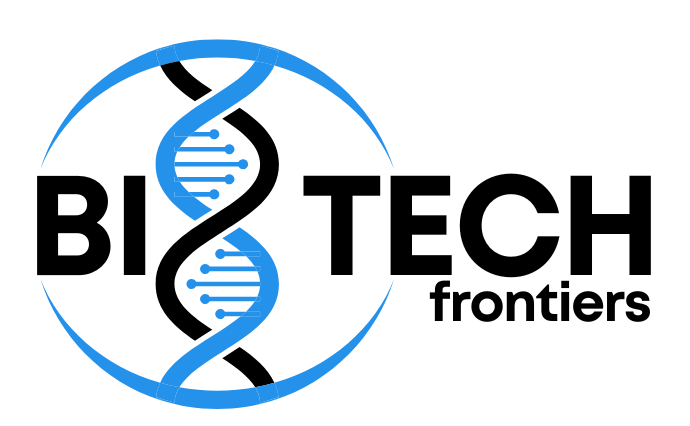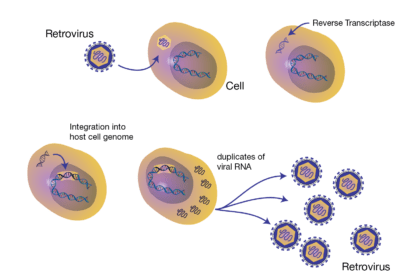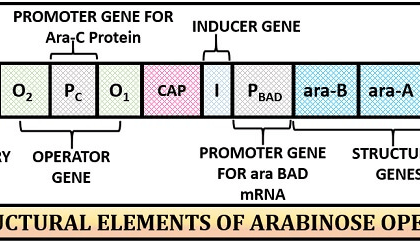Transposable elements
- A DNA element or sequences that can move from one location to another within genome or in a DNA molecule is known as transposable elements. It is also known as jumping genes or mobile DNA.
- The phenomenon of movement of transposable element within the genome from one location to another is known as transposition.
- Transposable elements were discovered by Barbara McClintock in 1948 in maize. For this discovery she was awarded Nobel Prize in 1983, 35 years after her discovery of transposable elements
Properties of TE
- TEs are ubiquitous in nature present in all organisms including bacteria, fungi, Protists, plants, and animals.
- These elements are prominent components of genomes i.e., more than 40% of the human genome is TEs and they clearly have a role in in shaping the structure of chromosomes and in modulating the expression of genes.
- Although each kind of TE has its own special characteristics however they share some common properties. The TEs code for an enzyme transposase which catalyses transposition.
- During transposition transposable element may break chromosome or mutate genes. Mostly transposition leads to target site duplication.
| Cut-and-Pastetransposons Transposition is accomplished by excising an element from its position in a chromosome and inserting in to another position. The excision and insertion events are catalyzed by transposase. The name cut and paste is because the element is physically cut out of one site in a chromosome and pasted into a new site |
| Replicative transposons. Transposition occurs by replication of TE DNA. TE encoded mediates an interaction between the element and a potential site. During this interaction, the element is replicated and one copy of it is inserted at the new site: one copy also remains at the original site. As there is a net gain of the element, it is refer as replicative transposition |
| Retrotransposons The process involves the insertion of copies of an element that were synthesized from the element’s RNA by reverse transcriptase which are then inserted in to new chromosomal sites. Because this mechanism reverses the usual direction in which genetic information flows in cells, it is refers as retrotransposition. And elements are refers as retrotransposons. |
Transposable Elements in Eukaryotes
- Transposons are present in eukaryotes vary in size, structure, and behavior. Some are abundant and other are rare in the genome. All the eukaryotic transposons have inverted repeats at their termini and create target site duplication when they insert into DNA molecule. Some encode a transposase that catalyzes the movement of the element from one position to another. Eukaryotes possess cut-and-paste TEs and retrotransposons.
- Ac and Ds elements in Maize
- P element in Drosophila

Ac and Ds elements in Maize
- Ac and Ds elements responsible for the coloring in maize were discovered by Barbara McClintock.
- Ds encode a factor which induces chromosomal breakage in the presence of factor called ‘Ac’ activator for its activity.
- The Ac/Ds system is responsible for the genetic instability in chromosome 9 in maize.
- Both the elements are structurally similar and can insert at many different sites on the chromosome leading to mutation in genes.
- Ac element consists of 4563 np bounded by inverted repeats (11 np). The ITR are essential for transposition
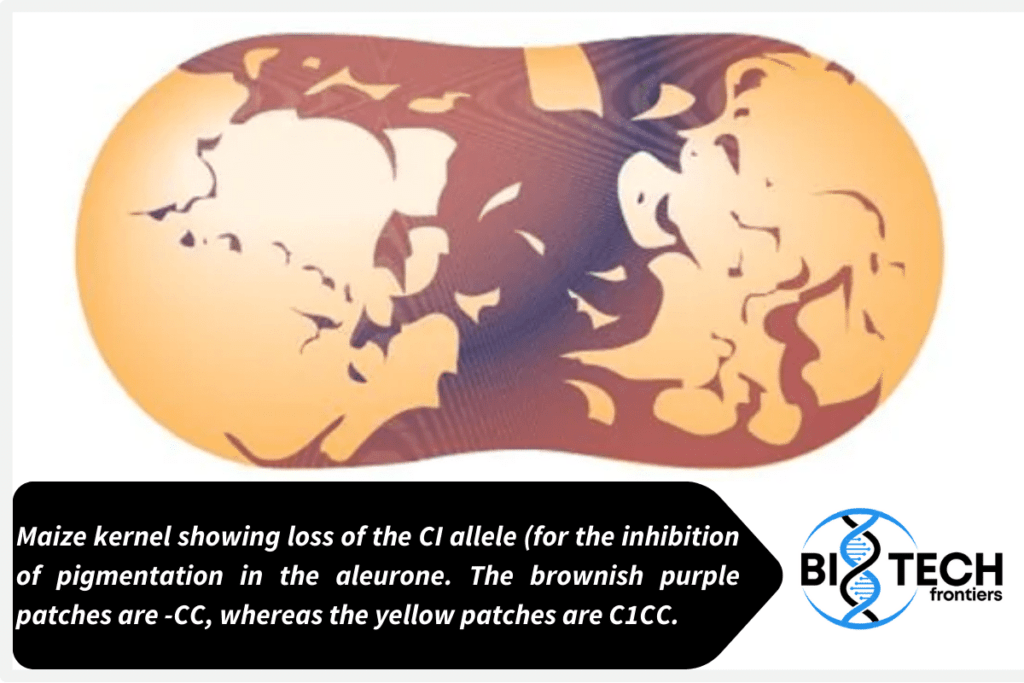
Chromosome breakage caused by the transposable element Ds in maize. The allele C on the short arm of
chromosome 9 produces normal pigmentation in the aleurone. The alleleCI inhibits this pigmentation.

- Each Ac element is flanked by direct repeats 8 np.
- Some Ds elements appear to have been derived from Ac element by the loss of internal sequences.
- The activities of the Ac/Ds elements i.e., excision and transposition, and all their genetic correlates, including mutation and chromosome breakage are caused by a transposase encoded by the Ac elements.
- The Ac transposase a trans-activating factor makes cleavage at or near the ends of Ac and Ds elements, catalyzing their movement. Ds element by them is generally inactive.
- Transposons related to the Ac/Ds element are also found in other species including animals like bobo element in Drosophila.

P element in Drosophila
P element causes hybrid dysgenesis (a deterioration in quality) Drosophila. Vary in size. Largest element is 2907 np long with ITR of 31np. Functional P element encode transposase binds near the ends of complete P element, move it to new location in the genome. Incomplete P element lacks the ability to produce the transposase because some of their internal sequences are deleted. Incomplete P element possessed ITR that can be bind by the transposase, consequently, can be mobilized. P elements are responsible for generating mutations in Drosophila. Geneticist routinely uses hybrid dysgenesis to obtain P insertion mutation in the laboratory.
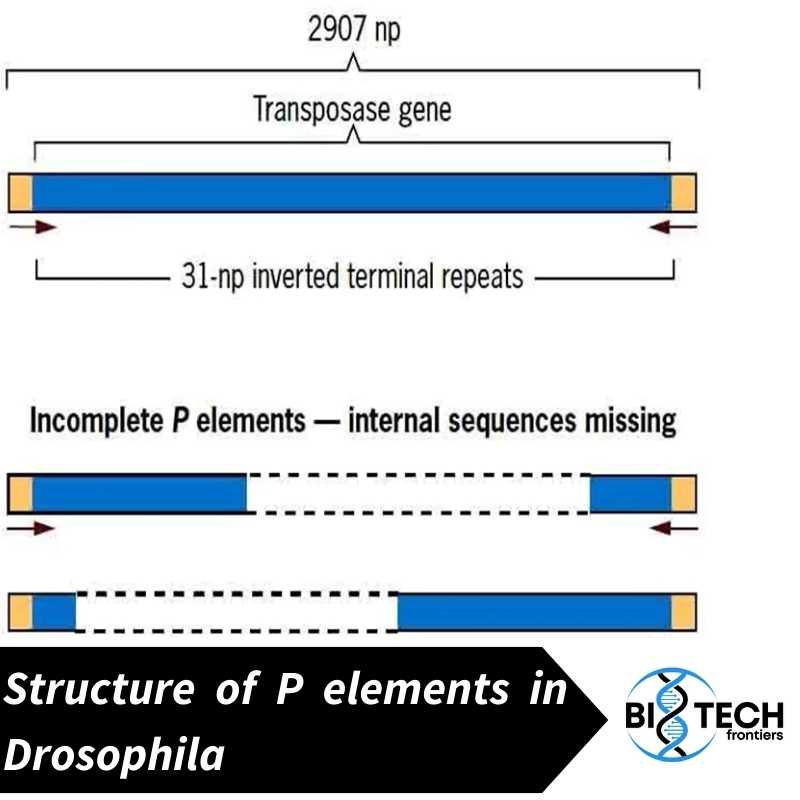
Structure of P elements in Drosophila
- Each element encodes both a transposase and a repressor (piRNA and piwi protein complex) of transposition.
- Transposase catalyzes transposition of P element while repressor inhibit P element movement.
- Hybrid dysgenesis, which is the sudden appearance of numerous mutations, chromosome aberrations, and sterility in the offspring of a cross between a P+ male fly (with P elements) and a P− female fly (without them).
- The reciprocal cross between a P+ female and a P− male produces normal offspring.
- Hybrid dysgenesis arises from a burst of transposition when P elements are introduced into a cell that does not possess them.
- In a cell that contains P elements, a repressor (piRNA) in the cytoplasm inhibits transposition
- When a P+ female produces eggs, the repressor is present in the egg cytoplasm, which prevents further transposition in the embryo and thus prevents mutations from arising.
- The resulting offspring are fertile as adults
- P − female does not produce the repressor. Since sperm contain very little cytoplasm, a P+ male does not contribute the repressor to his offspring.
- When eggs from a P− female are fertilized by sperm from a P+ male, the absence of repression allows the P elements contributed by the sperm to undergo rapid transposition in the embryo, causing hybrid dysgenesis.
- in dysgenic hybrids, P elements transpose only in the cells of the germ line

This restriction is due to the inability of the somatic cells to remove one of the introns from the P element’s pre-mRNA. When translated, this incompletely spliced RNA produces a polypeptide that does not have the transposase’s ability to catalyze P element movement. Resultantly the somatic cells are spared from the ravages of P element activity. Hybrid dysgenesis is, therefore, a strictly germline phenomenon. Mariner, an ancient and widespread transposon in Drosophila simulans and D. mauritiana is a 1286 np long with 28np ITR. Homolog of mariner has also been discovered in various organisms such as nematodes, fungi and even in humans.
FAQs on Transposable Elements in Eukaryotes
1. What are the primary types of transposable elements found in eukaryotes?
In eukaryotes, transposable elements (TEs) are classified into two major classes:
- Class I TEs (Retrotransposons): These move via an RNA intermediate and include long terminal repeat (LTR) retrotransposons, non-LTR retrotransposons such as LINEs (Long Interspersed Nuclear Elements), and SINEs (Short Interspersed Nuclear Elements).
- Class II TEs (DNA Transposons): These move directly as DNA and include elements such as the Ac/Ds system in maize and the P elements in Drosophila.
2. How do retrotransposons and DNA transposons differ in their mechanisms of transposition?
- Retrotransposons: Transpose through an RNA intermediate. The process involves transcription of the TE into RNA, reverse transcription into cDNA, and integration of the cDNA into a new genomic location.
- DNA Transposons: Move directly as DNA without an RNA intermediate. This involves a “cut and paste” mechanism where the TE is excised from one location and inserted into another, or a “copy and paste” mechanism for replicative transposition.
3. What is the significance of transposable elements in genome evolution?
Transposable elements play several critical roles in genome evolution:
- Genomic Innovation: They can create new genes and regulatory elements through insertional mutagenesis.
- Genomic Plasticity: TEs can cause chromosomal rearrangements, such as inversions, duplications, and deletions.
- Gene Regulation: TEs can influence gene expression by providing novel promoters, enhancers, or silencers.
4. How do host genomes control the activity of transposable elements?
Host genomes employ multiple mechanisms to control TE activity, including:
- DNA Methylation: Addition of methyl groups to TE sequences to suppress transcription.
- RNA Interference (RNAi): Small RNAs target TE transcripts for degradation or inhibit their translation.
- Chromatin Remodeling: Modification of histones around TEs to create a repressive chromatin state, preventing transcription.
5. What are some of the methods used to study transposable elements in eukaryotic genomes?
Several techniques are employed to study TEs, including:
- Genomic Sequencing: High-throughput sequencing to identify TE sequences and their insertion sites.
- PCR and RT-PCR: To amplify and study specific TE sequences and their expression.
- Chromatin Immunoprecipitation (ChIP): To study the association of TEs with histone modifications and regulatory proteins.
- Bioinformatics Tools: Computational methods to annotate TEs, analyze their distribution, and assess their impact on the genome.
6. Can transposable elements be beneficial to the host organism?
Yes, while TEs are often seen as genomic parasites, they can also provide benefits:
- Adaptive Evolution: Insertion of TEs can lead to beneficial mutations and new regulatory networks.
- Stress Response: TEs can become activated under stress conditions, potentially leading to beneficial genetic variation.
- Immune System Evolution: TEs have contributed to the evolution of immune system genes, such as those involved in V(D)J recombination in vertebrates.
7. What is the impact of transposable elements on human health?
TEs can have both positive and negative impacts on human health:
- Genetic Disorders: TE insertions can disrupt genes or regulatory regions, leading to diseases like hemophilia, muscular dystrophy, and certain cancers.
- Immune System Diversity: TEs have played a role in the evolution of the adaptive immune system, which is crucial for defending against pathogens.
- Gene Therapy: TEs are being explored as tools for gene therapy, allowing for the insertion of therapeutic genes into the human genome.
8. How do transposable elements interact with epigenetic modifications?
TEs are often targeted by epigenetic modifications to suppress their activity:
- Methylation: TEs are frequently methylated at cytosine residues, leading to transcriptional silencing.
- Histone Modifications: TEs can be associated with repressive histone marks, such as H3K9me3, which prevent their transcription and movement.
- Non-coding RNAs: Small RNAs, such as piRNAs, are involved in recognizing and silencing TEs through RNA-induced transcriptional silencing complexes.
References
- 2008 Pearson Education Inc. publishing as Pearson Benjamin Cummings
- Genetics: A conceptual Approach by Benjamin A. Pierce, 3rd edition 2009, WH Freeman and Company
- Principles of Genetics Sixth Edition by D. Peter Snustad and Michael J. Simmons, John Wiley & Sons, Inc.
Further resources
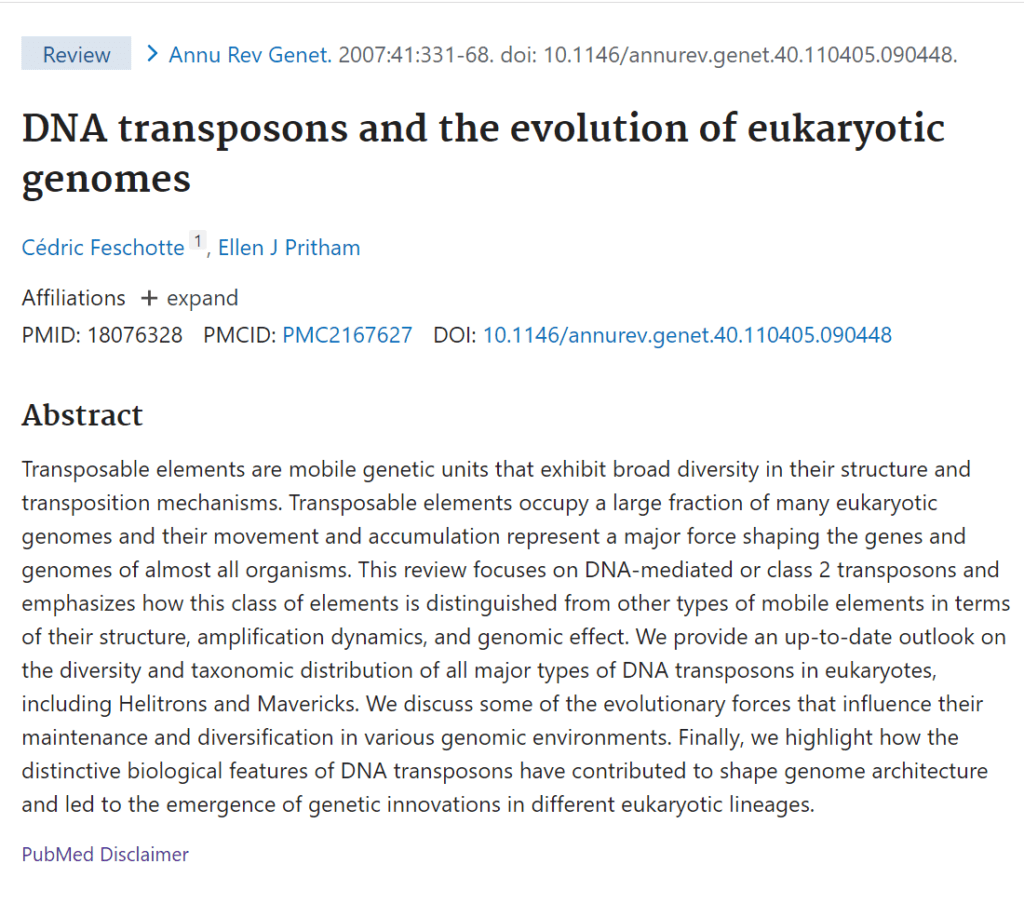 |
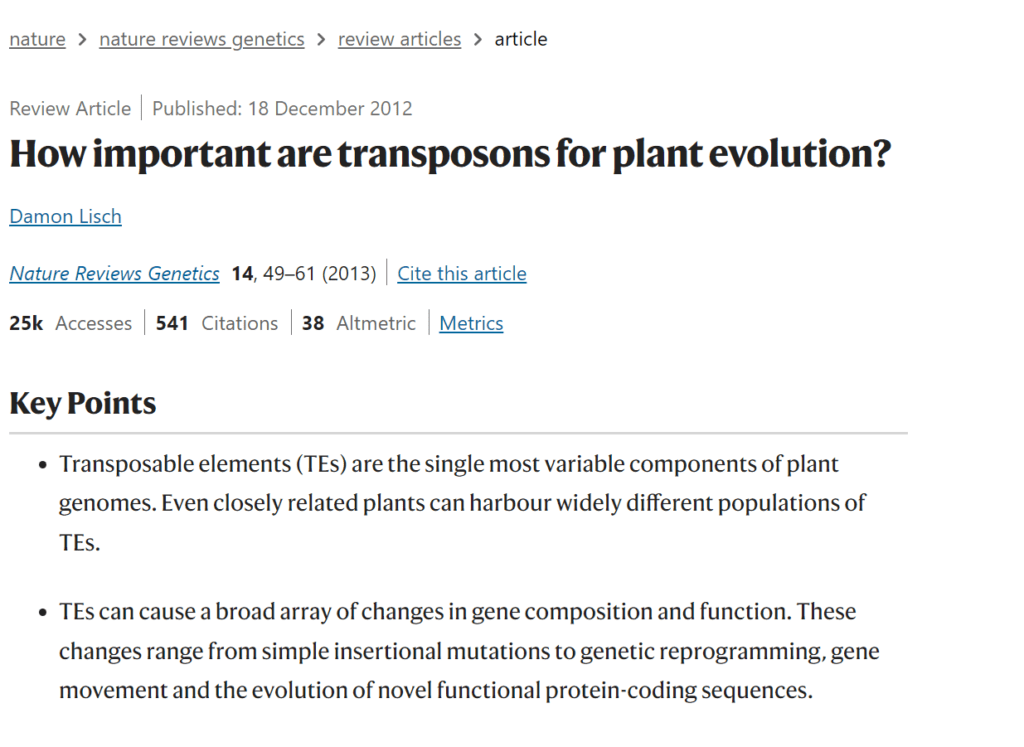 |
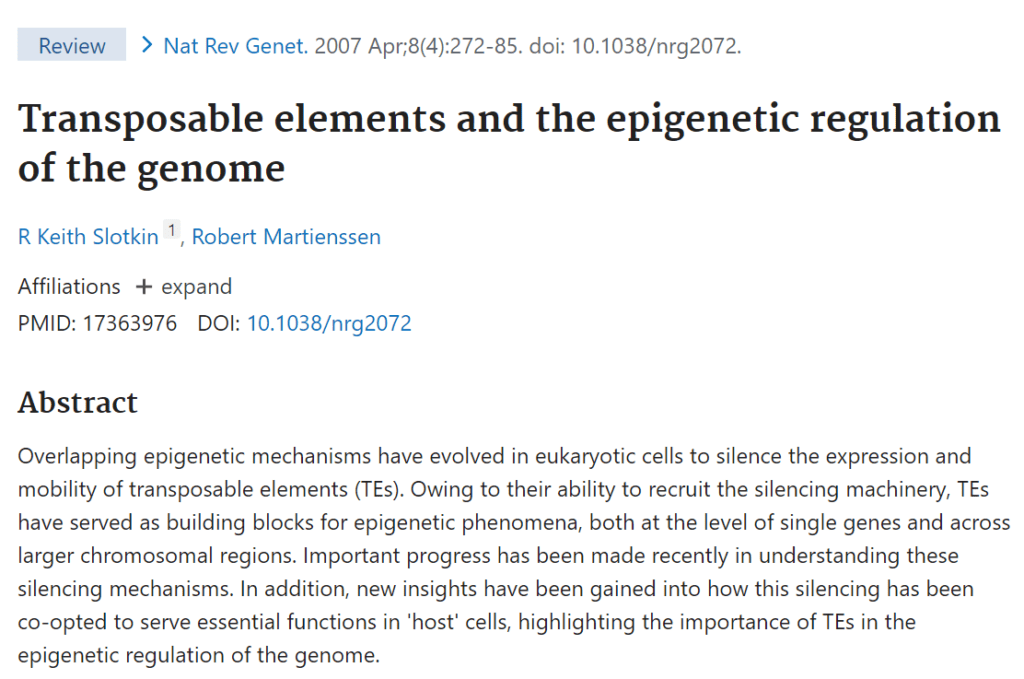 |
